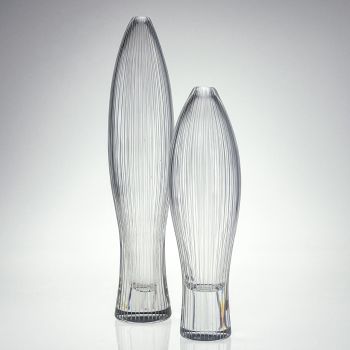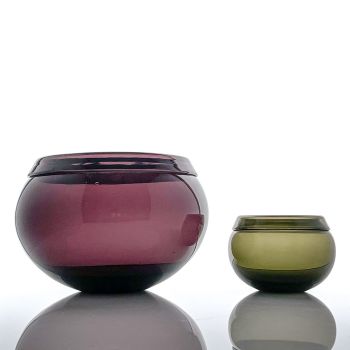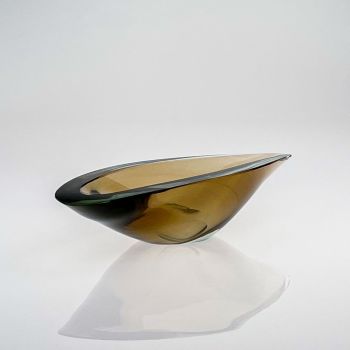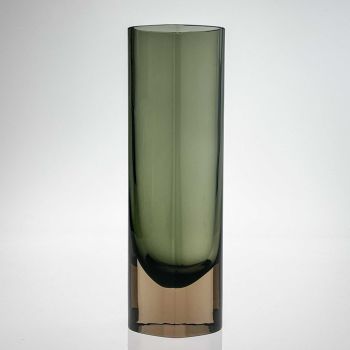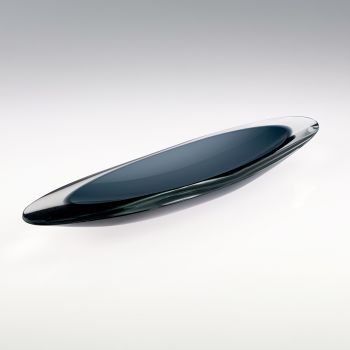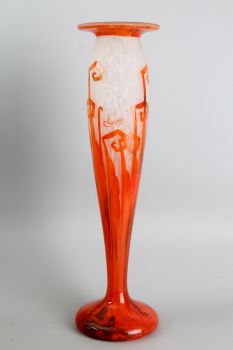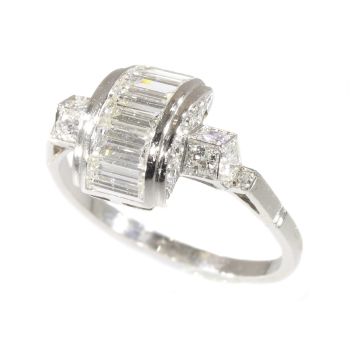Crystal Art-Object with sodium bubbles, model 3242 - Iittala, Finland circa 1948 1948 - 1949
Tapio Wirkkala
CristalGemme
14 cm, ø 8 cm
ConditionVery good
Actuellement indisponible via Gallerease
- Sur l'oeuvre d'artMold blown, crystal Art-object with sodium bubbles, model 3242. Designed by Tapio Wirkkala in 1948. This model was only produced for two years, namely 1948 or 1949 by the craftsmen at the Iittala glassworks in Finland.
The glassmass was blown in a special mold after which it was formed in the final shape while still hot. The bubbles in the glass were created by adding sodium into the glassmass. These particals would chemically react and form bubbles.
Execution Collapse
Iittala, Finland between 1948-1949
Marked
Tapio Wirkkala - Iittala in diamondpen
Condition
Good overall condition, minor wear consistent of age and use. No cracks or chips.
Literature
Marianne Aav, TAPIO WIRKKALA eye, hand and thought: p. 395
Dimensions
H. 14.1 cm
Diam. 8.57 cm
Weight 910 grams
About Tapio Wirkkala
Tapio Wirkkala (1915 Hanko, Finland - 1985 Helsinki, Finland) A giant of Finnish design, Wirkkala was an artist of great diversity for whom no material was alien and who left no area of design unexplored.
A glass design competition held by the Iittala glassworks in 1946 was the event that set his career in motion; the first prize went jointly to Wirkkala and Kaj Franck.
With an oeuvre that ranges from exceptionally beautiful pieces of glass art to industrial design in the form of beer bottles and banknotes, Wirkkala also designed jewellery, sculptures, and furniture.
The recipient of many awards, honorary titles, and a doctorate, Wirkkala won three Grand Prix medals at the Milan Triennale in 1954 and an additional Grand Prix medal and gold medal at the Milan Triennale in 1960. - Sur l'artiste
Tapio Wirkkala (1915-1985) était un génie du design aux multiples talents, largement considéré comme une figure de proue de l'art industriel finlandais moderne. Le vaste portefeuille de Wirkkala s'étend du verre, du mobilier et de la conception de produits à la sculpture, à l'urbanisme, à l'art, au graphisme et même à la création de billets de banque pour le Trésor finlandais.
Tout au long de sa carrière incroyablement productive, Wirkkala a reçu de nombreux prix, dont trois médailles d'or à la Triennale de Milan, le prix Lunning, la médaille Pro Finlandia et la médaille Prince Eugen.
En 1946, Wirkkala remporte son premier prix de design dans le cadre d'un concours parrainé par Iittala qui marquera une relation à vie avec des effets durables sur sa carrière et sur l'entreprise. En tant que directeur artistique d'Iittala, la vision artistique unique de Wirkkala a contribué à établir la réputation mondiale de l'entreprise.
Tout au long de sa carrière légendaire, l'artiste au talent unique a créé plus de quatre cents objets en verre pour Iittala, dont beaucoup, comme les séries Ultima Thule et Tapio, restent populaires aujourd'hui.
Artwork details
Related artworks
- 1 - 4 / 9
- 1 - 4 / 24
Johann Loetz (Lötz) Witwe Klostermühle
Johann Loetz Witwe - Phänomen Genre 7773 – Orange1900 - 1910
Precio a consultarAntiques Emporium
Johann Loetz (Lötz) Witwe Klostermühle
Johann Loetz Witwe – Ausfuehrung 146 Titania vase – 19121910 - 1919
Precio a consultarAntiques Emporium
1 - 4 / 24- 1 - 4 / 24














